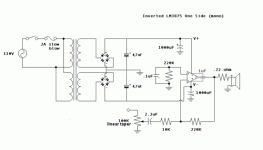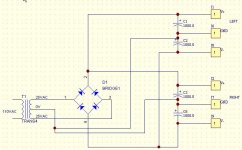soft diodes.
I believe you are quoting the reverse leakage of the devices at specified temperature and reverse bias.
A reverse spike, or turn off transient, is measured in one of two ways..using the TRR setup as per mil spec, with the 1/2 amp forward, 1 amp reverse, 1/4 amp recovery circuit...or, by the recovered charge method typical of larger devices.
The recovered charge method uses inductive slew defined waveforms, giving both a peak current, and an integrated area for calculation of recovered charge.
So, I believe the discussion is regarding the normal TRR setup.
A soft recovery diode is one which does not abruptly turn off in response to reverse current, but instead, lets go slowly.
Cheers, John
millwood said:
just wanted to give you some perspective: the reverse spike for a gbu8 is about 5ua at room temperature and 500ua at 125 dgrees?
Guesss what the reverse spike is for mur860?
how about 10ua at room temperature and 500ua at 125 dgrees.
slightly worse than the lowly gbu8.
I believe you are quoting the reverse leakage of the devices at specified temperature and reverse bias.
A reverse spike, or turn off transient, is measured in one of two ways..using the TRR setup as per mil spec, with the 1/2 amp forward, 1 amp reverse, 1/4 amp recovery circuit...or, by the recovered charge method typical of larger devices.
The recovered charge method uses inductive slew defined waveforms, giving both a peak current, and an integrated area for calculation of recovered charge.
So, I believe the discussion is regarding the normal TRR setup.
A soft recovery diode is one which does not abruptly turn off in response to reverse current, but instead, lets go slowly.
Cheers, John
fdegrove said:Hi,
An other one but obviously not as well behaved:
Cheers,
Hi fd
What must be pointed out here is that the overshoot and ringing is a direct result of the geometry of the fixture being used to test the diode, in addition to the error component of the current viewing resistor.. Diodes do not ring in this fashion..(unless you talk high gig freq's.)
But, of importance is the fact that a fixture designed for high speed (relatively, of course), rings like that with that diode. Normal circuitry can have seriously higher overshoot and ringing.
Cheers, John
miguel2 said:I used BC caps I took off a broken tv set...
BTW, how many bridges do you guys use for the GC? Do you separate the channels with different bridges? I saw in other forum someone saying that the original power humpty has only one bridge.
Miguel
I use this schematic with two bridges per channel.
Jan
Attachments
Today, I receive my 4 * MUR860 but I think I maked an error, I need 8 * MUR860 ????
I look at the data sheet, and a MUR860 is "only" a diode.
If it is that, I need 4 diode to make a positive with the AC, and 4 other diode to make the negative ???
If this isn't try, tell my how to make something with the MUR860 ??
thank !!!
I look at the data sheet, and a MUR860 is "only" a diode.
If it is that, I need 4 diode to make a positive with the AC, and 4 other diode to make the negative ???
If this isn't try, tell my how to make something with the MUR860 ??
thank !!!
arold19 said:Today, I receive my 4 * MUR860 but I think I maked an error, I need 8 * MUR860 ????
I look at the data sheet, and a MUR860 is "only" a diode.
If it is that, I need 4 diode to make a positive with the AC, and 4 other diode to make the negative ???
If this isn't try, tell my how to make something with the MUR860 ??
thank !!!
You need at least 8 diodes if you ar going to use one PS for both channels and your PS uses a one bridge per rail. You can still use only 4 diodes if you use single bridge and center tap of the transformer.
arold19 said:I don't understand what you mean by center tap ???
If I have 2* 25 Vac I use 25 V for the positive and 25 for the negative .....
what is the center tap ???? all transformer have that ???
Here it is. The 1000uF should be connected directly to the pins of the IC.
Attachments
Original Humpty Diodes
Just in case anyone's interested, here's some information on the diodes used in the original 50 watt Humpty unit from 47 Labs:
They are glass passivated FE5D 9808 diodes.
Here are some links regarding the original post on these:
http://www.audioasylum.com/audio/tweaks/messages/60943.html
http://pub134.ezboard.com/ffakeidsfrm1.showMessage?topicID=241.topic
Regards,
KT
Just in case anyone's interested, here's some information on the diodes used in the original 50 watt Humpty unit from 47 Labs:
They are glass passivated FE5D 9808 diodes.
Here are some links regarding the original post on these:
http://www.audioasylum.com/audio/tweaks/messages/60943.html
http://pub134.ezboard.com/ffakeidsfrm1.showMessage?topicID=241.topic
Regards,
KT
Re: Original Humpty Diodes
FE5D datasheet:
http://www.vishay.com/docs/86071/86071.pdf
9805 is the manufacturing date I guess.
KT said:Just in case anyone's interested, here's some information on the diodes used in the original 50 watt Humpty unit from 47 Labs:
They are glass passivated FE5D 9808 diodes.
Here are some links regarding the original post on these:
http://www.audioasylum.com/audio/tweaks/messages/60943.html
http://pub134.ezboard.com/ffakeidsfrm1.showMessage?topicID=241.topic
Regards,
KT
FE5D datasheet:
http://www.vishay.com/docs/86071/86071.pdf
9805 is the manufacturing date I guess.
Re: Re: Original Humpty Diodes
given the beautiful sound from the humpty, those rectifiers must be a ultra soft-recovery type,
GregGC said:
given the beautiful sound from the humpty, those rectifiers must be a ultra soft-recovery type,
- Status
- This old topic is closed. If you want to reopen this topic, contact a moderator using the "Report Post" button.
- Home
- Amplifiers
- Chip Amps
- Rectifiers for the GC

